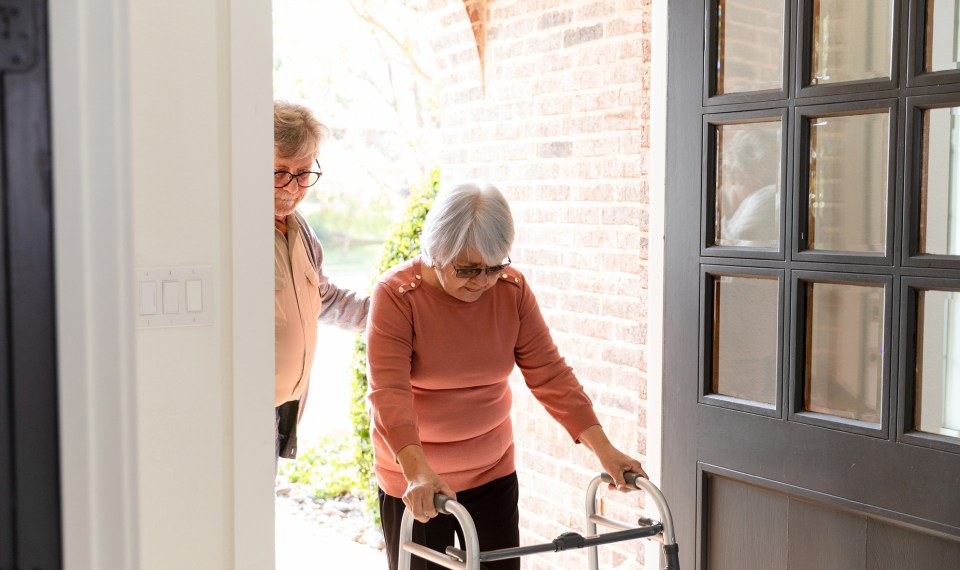When you think about getting older, where do you imagine yourself living? What about your parents or loved ones? Many older adults are choosing to age in place—stay in their homes or live in a residence of their choice for as long as possible. “It’s widely known that there is no place like home,” said Saloni Agarwal, a therapy leader and hip fracture specialist at Encompass Health Rehabilitation Hospital of Ocala. “There are memories associated with a personal dwelling, the accessibility of it and the trust in social support that make aging in place so appealing.” Older adults also cite a potential cost savings by remaining in their homes, a reduced sense of isolation and reduced stress related to relocation as reasons to age in place. According to the AARP’s recent Home and Community Preferences Survey, about 75% of the 3,000 participants 50 and older would like to stay in their current homes or communities for the long-term.
However, aging in place has its challenges. The home you love, and all the things in it, might not be as well-suited or as safe for you as your needs change. You might find it more difficult to go up and down stairs, retrieve items from cabinets and step in and out of your shower. If aging in place is important to you or your loved ones, take time to evaluate your home environment for safety and convenience.
The Importance of Fall Prevention
Falls are the leading cause of injury for those 65 and older, according to the Centers for Disease Control (CDC). In one of five cases, falls lead to serious injury like broken bones in the wrist, ankle and arm, and hip fractures, underscoring the importance of addressing potential hazards for older adults aging in place. “Falls occur when we lose the ability to regain our equilibrium. As we age, our balance receptors weaken, and reaction time to unanticipated situations decreases, resulting in reduced ability to maintain balance,” Agarwal said. Identifying and limiting fall risks are essential to keeping and maintaining a safe environment.
Remove Clutter and Tripping Hazards
- Remove any items from walkways. This can include boxes, shoes, electrical cords, phone chargers, small tables and plants. If there’s a pet or child in the home, be sure to keep toys and other loose items clear of walkways.
- Rearrange furniture to create straight walking paths in each room.
- Consider removing area rugs. If you choose to keep rugs, secure them with double-faced tape, tacks or a slip-resistant backing.
- For homes with sunken rooms or multi-surface floors, mark the difference in levels and surfaces with bright-colored tape.
- Wear non-slip socks or slippers around your home, especially on smooth floor surfaces like tile and hardwood.
- Place a small bell on the collar of dogs and cats so you can better hear them.
Making Stairs Safer
Stairs are one of the most common obstacles to an independent lifestyle. Many older adults invest in solutions for burdensome stairs by renovating to make living on the main floor possible and installing chair lifts or ramps. However, there are less extreme steps you can take to make your stairs safer.
- Install handrails on both sides of stairwells.
- Install slip-resistant stair treads. There are many options available, including easy-to-install stick-on treads in a variety of colors and textures to match your home.
- Ensure stairwells are well-lit. It helps to have a light switch within easy reach at the bottom and top of stairs.
- Like the rest of your home, it’s important to keep stairs free of clutter.
- Take your time as you climb up and down stairs.
Exercises for fall prevention
Our therapists shared simple exercises that can be done in your home.
See the exercises.Keep Items Within Reach and Accessible
“Falls are common when people reach out of their comfort zone to grab something from a high shelf, an object sitting further away or when picking up an object off the floor,” Agarwal said. With that in mind, consider your daily routine. What do you use the most often? Keep those items within easy reach. Here’s a few examples of keeping your home more accessible and organized:
- Keep pots, pans and utensils you use regularly on the counters.
- Use a reacher to retrieve items that are harder to get to.
- Keep a list of important phone numbers somewhere visible and accessible. The list should include family members or friends you can call in case of emergency.
- Store clothes you wear most often in areas of the closet or dressers that are the easiest to get to.
- Reorganize your refrigerator, pantry and other storage spaces to have the items you use frequently within easy reach.
- Use a pill box to organize and manage your medications.
Light Up Your Space
- Place night lights in your bedroom, bathroom and hallways.
- Place a lamp within reach of your bed in case you need to get up in the middle of the night.
- Consider trading traditional switches for glow-in-the-dark or illuminated switches.
- Turn on the lights before going up or down stairs.
- Store flashlights in easy-to-find places in case of power outages.
Technology for Fall Detection
While making modifications to your home can mitigate falls risks, accidents do happen. Wearing a fall detection device is an added safeguard in case of emergency. “I have recommended to caregivers using baby monitors or two-way camera systems for cognitively challenged patients in addition to smartwatches and life alert systems. Having neighbors or friends check in a couple of times during the day is also an economical way to stay safe, if they lack family support,” Agarwal, said.
There are numerous devices on the market that vary by budget and functionality. Speak with your doctor and loved ones to determine the right fit for you.
It’s Not for Everybody
As attractive as it is, aging in place isn’t suited for everyone. The tips in this article benefit all older adults, even if they don’t plan to remain in their home long-term. Speak to your doctor about your plans and concerns for the future to make the best decisions for yourself.
The content of this site is for informational purposes only and should not be taken as professional medical advice. Always seek the advice of your physician or other qualified healthcare provider with any questions you may have regarding any medical conditions or treatments.



